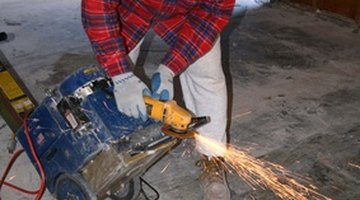Laying Tile With Crooked Walls
The first lesson many do-it-yourselfers learn is rooms are almost never square. Rooms maybe out of square from fractions of an inch to several inches.

Things You Will Need
- Measuring Tape
- Chalk Line
- Adhesive
- Wet Saw
Rooms are not normally square for a variety of reasons including the lumber that was used to build originally was not perfectly square and houses over the course of time tend to settle and shift. The older a home, the less likely the walls will be squared because as wood ages it can twist and warp depending on how dry the wood was when the room was first built. Just because your walls are not squared does not mean your flooring tiles will not look nice or that it will cause your crooked walls to be very obvious.
-
Measure the room from end to end and note the measurements; on the floor itself, mark the halfway points. Measure the room from side to side on each end of the room; note the measurements and mark the halfway points on the floor. Snap a chalk line (see Tips section). You will now have four large squares or quadrants marked on the floor.
-
Bring the end of your chalk line into a corner and extend it into the opposite corner. Snap the chalk line. Bring the end of your chalk line into the next corner and extend it into the opposite corner. Snap the chalk line.
-
Begin laying tiles using tile adhesive at the midpoint of the room. The midpoint is where all of the chalk lines intersect. The center of the tile should be positioned as closely as possible to the midpoint. Work out from the midpoint towards the wall. It is best to work in quadrants to avoid stepping or kneeling on the freshly laid tile and causing it to shift.
-
Leave all cuts until the end. As soon as you have whole tiles as close to the wall as possible without cuts, begin marking and cutting the remaining tile with a wet saw to fit the edges.
Tip
A chalk line is a piece of string that is rolled inside of a metal or plastic case and filled with powdered chalk. When the line is pulled out of the casing, it is covered in chalk. To snap a chalk line: Pull the string taut, grasp the string in the middle, pull it up and let it go. This action will result in a chalk line on the floor. The chalk line serves as your guide. To make crooked walls less noticeable, lay floor tiles on a diagonal rather than a straight line. Using un-patterned floor tiles will also make crooked walls less apparent. Do not create decorative tile borders because crooked walls will be highlighted.
Tips
- A chalk line is a piece of string that is rolled inside of a metal or plastic case and filled with powdered chalk. When the line is pulled out of the casing, it is covered in chalk.
- To snap a chalk line: Pull the string taut, grasp the string in the middle, pull it up and let it go. This action will result in a chalk line on the floor. The chalk line serves as your guide.
- To make crooked walls less noticeable, lay floor tiles on a diagonal rather than a straight line.
- Using un-patterned floor tiles will also make crooked walls less apparent.
- Do not create decorative tile borders because crooked walls will be highlighted.
Writer Bio
Sal Marco began writing professionally in 2009. He has written many online home improvement articles based on his more than 20 years of experience in the home improvement and building industries. He has worked as both part of a team and as a site supervisor. Marco has a Bachelor of Science in management science from Kean University.
Photo Credits
- floor care machine image by Greg Pickens from Fotolia.com
- floor care machine image by Greg Pickens from Fotolia.com
More Articles



